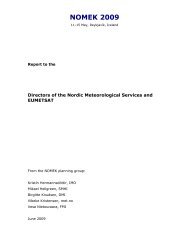International Symposium on Mitigative Measures against Snow ...
International Symposium on Mitigative Measures against Snow ...
International Symposium on Mitigative Measures against Snow ...
You also want an ePaper? Increase the reach of your titles
YUMPU automatically turns print PDFs into web optimized ePapers that Google loves.
<str<strong>on</strong>g>Internati<strong>on</strong>al</str<strong>on</strong>g> <str<strong>on</strong>g>Symposium</str<strong>on</strong>g> <strong>on</strong> <strong>Mitigative</strong> <strong>Measures</strong> <strong>against</strong> <strong>Snow</strong> Avalanches<br />
Egilsstaðir, Iceland, March 11–14, 2008<br />
Figure 1 312m l<strong>on</strong>g st<strong>on</strong>e-arched snow<br />
shed built at Splügenpass in<br />
1843. The snow shed was in<br />
operati<strong>on</strong> until 1950.<br />
Figure 2 130 m l<strong>on</strong>g snow shed built at<br />
Val Raschitsch in 2002 as a<br />
m<strong>on</strong>olithic jointless c<strong>on</strong>crete<br />
structure.<br />
2. EXPERIMENTAL INVESTIGATION OF AVALANCHE FORCES<br />
Between 2002 and 2006, scale experiments using granular material <strong>on</strong> a laboratory chute as<br />
well as large chute experiments with snow <strong>on</strong> the Weissfluhjoch (Davos) were used to<br />
determine the relevant dynamic parameters of flowing avalanches (Platzer and Margreth<br />
2007). In the laboratory approximately 100 experiments were performed <strong>on</strong> a wooden chute<br />
of 7 m length and 0.5 m width (Platzer and others 2004). On the Weissfluhjoch snow chute,<br />
which is 30 m l<strong>on</strong>g and 2.5 m wide, more than 50 experiments with 8 to 15 m 3 snow for each<br />
experiment were performed. Within both experimental setups a series of optical velocity<br />
sensors, ultras<strong>on</strong>ic flow height sensors and force plates − measuring the normal- and shear<br />
comp<strong>on</strong>ent of an avalanche over time − are used in combinati<strong>on</strong> to determine the<br />
characteristics of flowing avalanches when moving over a deflecting structure. The main<br />
findings of the experiments result in an improved approach to calculate the dynamic forces<br />
due to a deviati<strong>on</strong> and in more detailed data<br />
<strong>on</strong> the coefficient of fricti<strong>on</strong> depending <strong>on</strong><br />
the snow type (Fig. 3). Near the deviati<strong>on</strong><br />
point, meaning up to a distance of 1.5 times<br />
the flow height of an avalanche, the so far<br />
applied formula underestimates the applied<br />
dynamic forces, whereas after a distance of<br />
more than 6 times the flow height of an<br />
avalanche, the dynamic forces due to a<br />
deviati<strong>on</strong> have vanished. The mean coefficient<br />
of fricti<strong>on</strong> μ is for dry snow avalanches<br />
0.3 and for wet snow avalanches 0.5 (Platzer<br />
and others 2007). The measured coefficient<br />
Figure 3 Coefficient of fricti<strong>on</strong> μ as a<br />
functi<strong>on</strong> of the measured flow<br />
velocity <strong>on</strong> the snow chute.<br />
of fricti<strong>on</strong> is reduced by about 30% when the<br />
avalanche flows over a deposited snow<br />
cover.<br />
Margreth and Platzer 33











